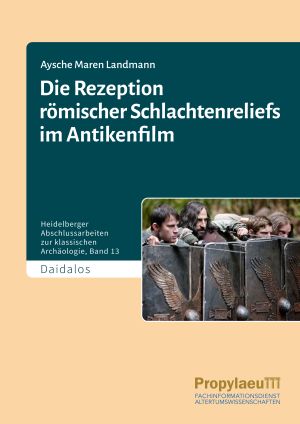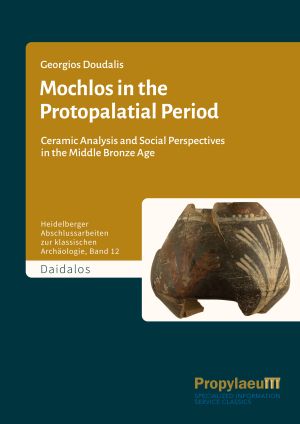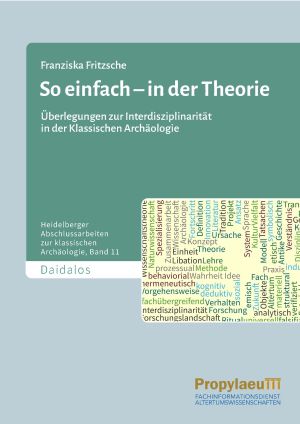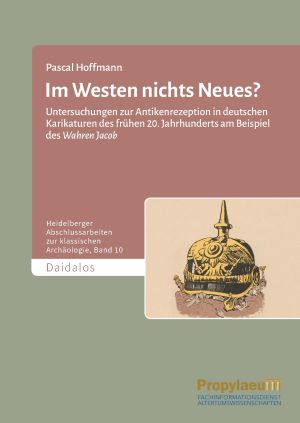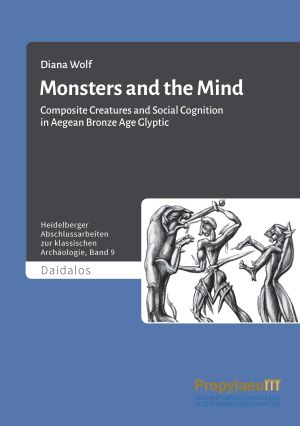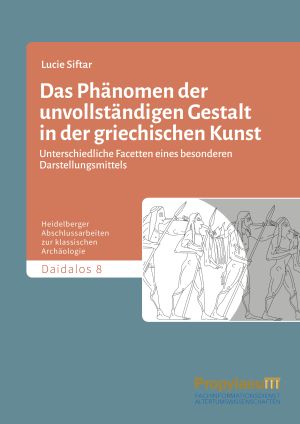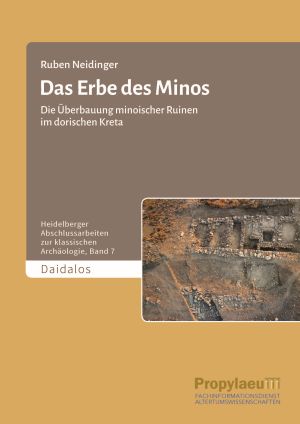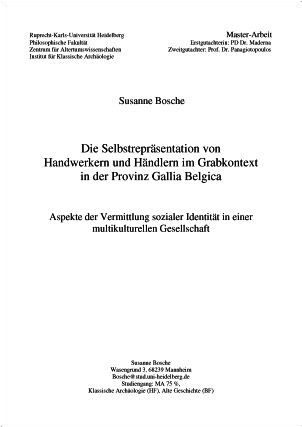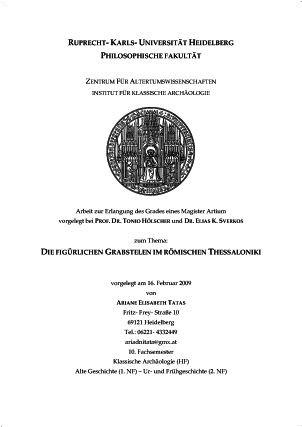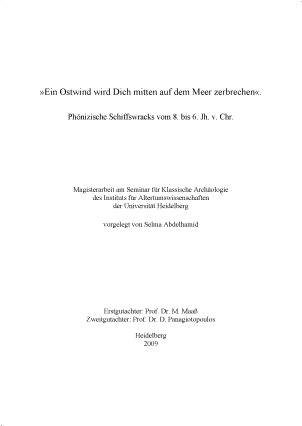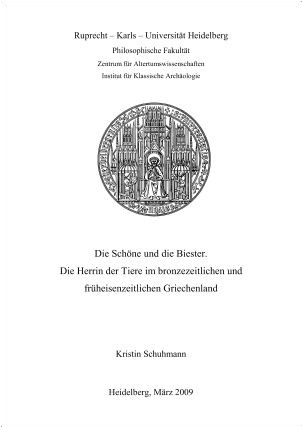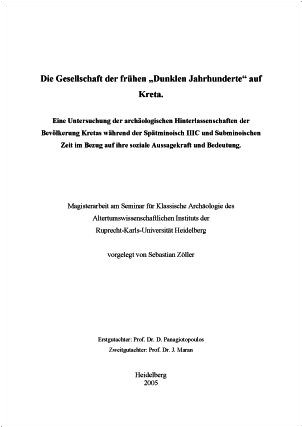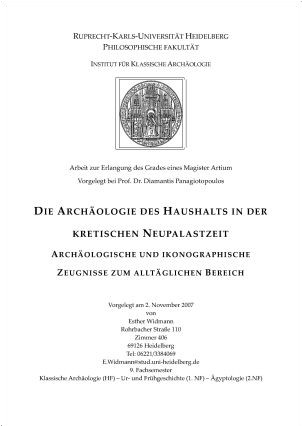Daidalos
Heidelberger Abschlussarbeiten zur Klassischen Archäologie
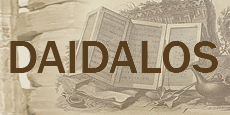
Kontakt
Prof. Dr. Diamantis Panagiotopoulos
Institut für Klassische Archäologie
Marstallhof 4
D-69117 Heidelberg
Tel.: +49 6221 54 2511
E-Mail: diamantis.panagiotopoulos@
zaw.uni-heidelberg.de
Erscheint demnächst
Bisher erschienen
Die Rezeption römischer Schlachtenreliefs im Antikenfilm
Darstellungen von Schlachten zeichnen nicht nur ein Bild von Sieg und Niederlage oder von „Freund“ und „Feind“, sondern enthalten auch ein dicht gewobenes Netz von Hinweisen darauf, was den „Feind“ eigentlich zum „Feind“ macht, warum es notwendig ist, ihn zu bekämpfen oder auf welche Weise der Sieg über ihn errungen wird.
Das Ziel der vorliegenden Arbeit ist es, an beispielhaften Exemplaren von Schlachtenreliefs der römischen Kaiserzeit und von Schlachtszenen moderner Antikenfilme diese Inhalte zu herauszuarbeiten und hierdurch Einblicke in die gesellschaftlichen Vorstellungen und Werte der Zeit zu ermöglichen, in welcher die Darstellungen entstanden sind. Dies soll aktuelle Sehgewohnheiten und -erwartungen von den Aussagen abgrenzbar machen, die Reliefs der römischen Kaiserzeit zugrunde liegen, und Impulse für eine unmittelbarere Betrachtung antiker Denkmäler geben.
Mochlos in the Protopalatial Period: Ceramic Analysis and Social Perspectives in the Middle Bronze Age
Dieses Buch konzentriert sich auf die Analyse des keramischen Materials, das an acht unterschiedlichen Stellen der Siedlung von Mochlos ausgegraben wurde und insgesamt eine Zeitspanne von MM IB (1925/1900-1875/1850 v.d.Z.) bis MM II (1875/1850-1750/1700 v.d.Z.) abdeckt. Da das Material aus Mochlos stratifiziert ist und sich über alle drei Unterphasen der altpalastzeitlichen Periode (MM IB-MM IIA und MM IIB) erstreckt, bietet es eine einzigartige Gelegenheit, Aspekte von Produktion, Distribution und Konsum des keramischen Materials und damit einhergehende soziale Dynamiken zu verstehen, und zwar sowohl innerhalb der Siedlung als auch in der breiteren Region des Mirabello Golfs und Ostkreta.
So einfach – in der Theorie: Überlegungen zur Interdisziplinarität in der Klassischen Archäologie
Die Anwendbarkeit von interdisziplinären Theorien in der Klassischen Archäologie steht im Mittelpunkt der vorliegenden Untersuchung. Zunächst wird dafür der Begriff der Wissenschaft und seine Entwicklungsgeschichte analysiert, um notwendige Fachtermini wie Inter-, Trans- und Multidisziplinarität ableiten zu können. Daran schließt eine Übersicht der Geschichte sowie der Methoden und Theorien der Klassischen Archäologie an. Da dem Fach ein Mangel an interdisziplinaren Theorien vorgeworfen wird, vergleicht die Autorin die Konzeption der Klassischen Archäologie mit der Arbeitsweise der Ur- und Frühgeschichte, da diese ein großes Spektrum an – teilweise widersprüchlichen – Theorieströmungen aufweist. Zu diesem Zwecke werden verschiedene Theorien der Ur- und Frühgeschichte ausgewählt und vorgestellt. Als letzter Schritt werden diese auf zwei Fallbeispielen aus der Klassischen Archäologie übertragen. Am Beispiel der Libationsrituale aus der bronzezeitlichen und klassischen Epoche Griechenlands soll untersucht werden, ob interdisziplinäre Theorien für die klassische Altertumsforschung anwendbar sind bzw. was die Voraussetzungen dafür wären.
Im Westen nichts Neues? Untersuchungen zur Antikenrezeption in deutschen Karikaturen des frühen 20. Jahrhunderts am Beispiel des Wahren Jacob
Die Erforschung der Rezeption griechisch-römischer Kunst und Kultur hat sich in der Vergangenheit weitgehend auf die sogenannten hohen Künste der Malerei, Bildhauerei und Literatur beschränkt, während einfachere, volkstümlichere Formen der Rezeption wenig beachtet wurden. Gerade die Karikatur als Medium mit dem Anspruch einer universalen, verständlichen Botschaft bietet jedoch Möglichkeiten, das Wissen über die Antike in Milieus zu erforschen, denen die bürgerliche und künstlerische Bildung der Oberschicht verwehrt blieb. Dieser Beitrag untersucht anhand der sozialistischen Karikaturen-Zeitschrift Der Wahre Jacob, wie weit der klassische Bildungskanon der wilhelminischen Oberschicht von der oppositionellen Subkultur des Proletariats aufgegriffen und verstanden wurde, und wirft damit ein Schlaglicht auf einen Aspekt der gesellschaftlichen Gegensätze in der Zeit unmittelbar vor und um den Ersten Weltkrieg.
Monsters and the Mind: Composite Creatures and Social Cognition in Aegean Bronze Age Glyptic
Monsters and the Mind ist eine erste systematische Erfassung des bestehenden Repertoires an „Monster“-Darstellungen auf bronzezeitlichen Siegeln und Siegelabdrücken aus der Ägäis mit einem besonderen Fokus auf das minoische Kreta. Die Arbeit kategorisiert und typologisiert Hybride und Mischwesen, wie Greifen und Vogelfrauen, Minoische Genii und Drachen, und interpretiert diese im kulturhistorischen Kontext ihrer jeweiligen Entstehungs- und Umlaufzeit. Ein umfassender Katalog aller publizierter Siegel, die Hybride und Mischwesen führen, ergänzt die typologischen und interpretativen Ansätze des Textes.
Das Phänomen der unvollständigen Gestalt in der griechischen Kunst: Unterschiedliche Facetten eines besonderen Darstellungsmittels
Obwohl die unvollständige Gestalt als Bestandteil eines narrativen Kontextes in der griechischen Flächenkunst vielfach greifbar ist, hat sie bislang noch nicht die Aufmerksamkeit erfahren, die sie verdient. Das vorliegende Werk unternimmt erstmals eine systematische Auseinandersetzung mit diesem Phänomen. Besonders am Beispiel der Vasenbilder kann gezeigt werden, dass es sich bei dem Abschneiden einer Figur durch den Rahmen zumeist um ein sehr bewusst herangezogenes Darstellungsmittel handelt. Auf diese Weise kann nicht nur Bildraum eingespart und zugleich Handlungsraum gewonnen werden, sondern es lassen sich an die Teilfigur auch unterschiedliche semantische Werte knüpfen. Ausgehend von den Gesetzmäßigkeiten der optischen Wahrnehmung machten sich die Bilderzeuger eben diese kreativen Möglichkeiten zunutze, ihre dargestellten Inhalte mit gesteigerter Effizienz in Szene zu setzen und den Betrachter in höchstem Maße einzubinden.
Das Erbe des Minos: Die Überbauung minoischer Ruinen im dorischen Kreta
Das Interesse der archäologischen Forschung zu und auf der Insel Kreta hat sich seit den Ausgrabungen von Knossos durch Arthur Evans stets auf die dort entdeckte Zivilisation der minoischen Bronzezeit konzentriert. Die nachfolgenden Epochen von der frühen Eisenzeit bis in die römische Kaiserzeit wurden dagegen oft in weitaus geringem Ausmaß erforscht, unter anderen deshalb, weil ihre Befunde nicht mit den spektakulären Monumenten der übrigen griechischen Welt konkurrieren konnten und Kreta in diesen Phasen seiner Geschichte keine bedeutende historische Rolle gespielt zu haben scheint. Daher haben Gebäuden aus den späteren, dorischen Epochen der Insel, die teilweise direkt auf den Mauern der bronzezeitlichen Strukturen sitzen, weitaus geringere Aufmerksamkeit erfahren als die minoischen Befunde. Die vorliegende Arbeit plant diese Forschungslücke ein Stück weit zu schließen, die einzelnen Befunde, in denen eine Überbauung minoischer Strukturen durch spätere Architektur ab der geometrischen Zeit bis in die römische Kaiserzeit vorliegt, zusammenzutragen und erstmals in einer Gesamtübersicht darzustellen und zu interpretieren. Hierbei wird sich zeigen, dass die Überbauungen vor allem aus der geometrischen-(früh)archaischen und aus der hellenistischen-römischen Zeit stammen. Ihre Interpretation versucht dieses Phänomen in den Kontext der historischen Entwicklung Kretas in diesen Epochen zu stellen und nachzuweisen, dass die Überbauung minoischer Gebäude absichtlich aus einem bestimmten Grund geschah. Vor allem die zahlreichen Heiligtümer im Umland der Städte, könnten darauf hindeuten, dass es hier um die Beanspruchung von Territorium ging. Im Zusammenhang mit den Palästen soll auch die Bedeutung der Mythen um König Minos im dorischen Kreta untersucht werden. Inwieweit hier die minoische Kultur von den späteren Kretern als ihre Vorfahren wahrgenommen wurden, wird ebenfalls diskutiert.
Die Selbstrepräsentation von Handwerkern und Händlern im Grabkontext in der Provinz Gallia Belgica: Aspekte der Vermittlung sozialer Identität in einer multikulturellen Gesellschaft
Der Schwerpunkt der vorliegenden Arbeit liegt auf einer Untersuchung des sozialen Hintergrundes der Selbstrepräsentation von Handwerkern und Händlern im Grabkontext in der römischen Provinz Gallia Belgica des 2. und 3. Jahrhunderts u.Z., sowie einiger erkennbarer Phänomene des verstärkten Kontaktes der einheimischen Bevölkerung mit der römischen Kultur. Der erste Teil der Arbeit legt nahe, dass die hohe Zahl von steinernen Grabmälern von Handwerkern und Händlern im betrachteten Zeitraum primär im Kontext von Veränderungen in der Memorialkultur und den verwendeten Materialien zu stehen scheint und nicht ausschließlich auf soziale oder wirtschaftliche Aspekte zurückgeführt werden kann.
Die ikonographische Gestaltung der Grabmäler, die im zweiten Teil hinsichtlich ihrer wirtschaftlichen Aspekte untersucht wird, lässt keine Verfestigung der Bildersprache als Ausdruck eines Kollektivbewusstseins erkennen. Konzeptueller Hintergrund der Repräsentativität von Handwerk und Handel ist das Herstellen von Produkten hoher und nachprüfbarer Qualität, wobei der Transport der Waren zu einem überregionalen Zielort eine wichtigere Rolle einnimmt als der Verkauf selbst, in dessen Rahmen zudem die Interaktion mit den Kunden über die Waren, und nicht deren Umtausch gegen Geld im Vordergrund steht. Die im dritten Teil untersuchte soziale Einordnung der Personen ist nur unter Einschränkungen möglich, insbesondere kann der Rechtsstatus anhand der momentanen Quellen- und Forschungslage nicht überzeugend rekonstruiert werden. Namensgebung und Kleidung legen jedoch nahe, dass es sich vorwiegend um Angehörige der lokal ansässigen Bevölkerung handelt. Die verwendeten, äußerst heterogenen Grabmalformen lassen durch verschiedene Tendenzen der Ausweitung des memorialtechnischen Anspruches im Rahmen der Erinnerungskultur einen Anspruch auf Sozialprestige erkennen, welcher in vielen Fällen mit einer Charakterisierung der Person durch Prestigewaren kombiniert wird. Der so erkennbare Prestigeanspruch fällt tendenziell mit einer zunehmenden Orientierung an Elementen aus der römischen Kultur zusammen. Aufgrund der fehlenden Thematisierung politischer Ambitionen und der im wirtschaftlichen Bereich erkennbaren Phänomene sollte von einer zumindest partiellen Etablierung von Internationalität als sozial relevanten Wert ausgegangen werden.
Die figürlichen Grabstelen im römischen Thessaloniki
„Ταῦτα, φίλοι ∙ μετὰ ταῦτα τί | γὰρ πλέον; οὐκέτι ταῦτα. |στήλλη ταῦτα λαλεῖ καὶ λί|θος ∙ οὐ γὰρ ἐγώ“. Mit diesen Worten kommt ein Grabepigramm des 3. Jhs. n. Chr. aus Eumeneia in Phrygien zu einem Abschluss. Gewinnt man bei den ersten Worten noch den Eindruck der Tote wende sich ein letztes Mal an den Passanten und Betrachter seiner Grabstele, so versteht sich von selbst, dass man enttäuscht werden muss. Denn welche Hoffnungen oder Befürchtungen unser Gaius auch immer an das Jenseits knüpfte, gewiss bleibt nur, dass wir ihn nicht mehr zum Sprechen bringen werden. In diesem Sinn sei hier ein Versuch gewagt, doch zumindest die Sprache der Grabsteine, in Wort und Bild, zu deuten. So befasst sich die vorliegende Arbeit mit der Untersuchung der figürlichen Grabstelen der Stadt Thessaloniki und ihrer chora in römischer Zeit, das heißt in erster Linie vom frühen 1. Jh. v. Chr. bis gegen Ende des 3. Jhs. n. Chr.2. Ziel war es dabei, das komplette Material aufzunehmen.
»Ein Ostwind wird Dich mitten auf dem Meer zerbrechen«: Phönizische Schiffswracks vom 8. bis 6. Jh. v. Chr.
Jahrhundertelang fuhren phönizische Schiffe, vom Wind angetrieben, von der syrischlibanesischen Küste über das Mittelmeer u nd über seine Grenzen hinaus. Die Berichte dieser Erkundungs- und Handelsfahrten wurden größtenteils nicht überliefert. Bis Mitte des 20. Jh. wurden keine Fahrzeuge aufgefunden, so dass sich der Wissenschaft ein äußerst beschränktes Bild des phönizischen Seewesens bot. Seit wenigen Jahrzehnten jedoch sind mehrere Wracks bekannt, Selbst ‚zerbrochen’ und versunken sind diese Schiffe als anschauliche Zeugnisse früheisenzeitlicher und archaischer Kommunikationsstrukturen zu betrachten, die erstmals eine direkte Rekonstruktion des phönizischen Handels in seiner Blütezeit erlauben. Die Wracks in Ashkelon belegen den Weinhandel. im östlichen Mittelmeer, jene in Mazarrón bringen Erkenntnisse zum Schiffsbau und dem aktiven Handel auf der iberischen Halbinsel. Die Befunde in Bajo de la Campana und Rocheslongues schließlich bezeugen den Handel mit Rohstoffen, der in Kontexten an Land nur selten nachgewiesen werden kann.
Die Schöne und die Biester: Die Herrin der Tiere im bronzezeitlichen und früheisenzeitlichen Griechenland
Die vorliegende Magisterarbeit hat die Untersuchung der frühesten Darstellungen der Herrin der Tiere im bronzezeitlichen und früheisenzeitlichen Griechenland und Kreta zum Thema. Das Schema dieses Motivs ist im gesamten Mittelmeerraum sowie Mittel- und Südeuropa bis hin nach Vorderasien und Ägypten durch viele Epochen und Kulturkreise hindurch weit verbreitet. Gegenstand der Untersuchung ist eine Gruppe von Bildwerken des 2. und frühen 1. Jahrtausends v. Chr. an, auf denen eine als Gottheit interpretierte weibliche Figur in Verbindung mit Tieren dargestellt ist. Für diese Gottheit hat sich deshalb die Bezeichnung „Herrin der Tiere“ (Potnia Theron) eingebürgert. Es handelt sich um eines der wichtigsten und in ihrer Deutung schwierigsten Bildthemen der ägäischen und frühgriechischen Kultikonographie. Schwerpunkte der Untersuchung bildet die systematische Untersuchung der unterschiedlichen Schemata der Herrin der Tiere sowie der Analyse der Natur dieser Gottheit. In der Folge werden Anhaltspunkte für die Ursprünge und sekundär auch für die Kontinuität der Darstellung und für die Kulturkontakte zu Vorderasien und dem ägäischen Raum gesucht.
Die Gesellschaft der frühen „Dunklen Jahrhunderte“ auf Kreta: Eine Untersuchung der archäologischen Hinterlassenschaften der Bevölkerung Kretas während der Spätminoisch IIIC und Subminoischen Zeit im Bezug auf ihre soziale Aussagekraft und Bedeutung
Im Rahmen der hier vorgelegten Arbeit „Die Gesellschaft der frühen ‚Dunklen Jahrhunderte’ auf Kreta“ soll der Versuch unternommen werden, ein Bild der gesellschaftlichen Strukturen auf Kreta zu dieser Zeit zu erstellen. Dabei steht die Untersuchung der archäologischen Quellen und Hinterlassenschaften der kretischen Bevölkerung im Mittelpunkt, um Fragen nach der Stratifizierung der Gesellschaft nachzugehen und die politische Situation auf der Insel zu klären. Auch werden Aspekte der Wirtschaft und des Handels, sowie der Religion und des Kultes als Bestandteile des alltäglichen Lebens betrachtet, soweit sie archäologisch fassbar sind. Die chronologische Spanne der bearbeiteten Epoche umfasst die Phase Spätminoisch IIIC und die Subminoische Zeit, also den Abschnitt der kretischen Prähistorie nach dem endgültigen Zusammenbruch der mykenischen Palastkultur um 1200 v. Chr., die nach der Zerstörung der minoischen Paläste um 1490 v. Chr, auch die Kontrolle über die Insel Kreta innehatte. Die Ergebnisse dieser Untersuchungen spiegeln gleichermaßen ein Bild von Kontinuität und Wandel wider, welches alle Bereiche des täglichen Lebens betrifft. Der Hauptteil der Arbeit enthält einen umfassenden Katalog aller chronologisch relevanten Fundorte der Insel und die Auswertung der archäologischen Quellen in Bezug zu ihrer sozio-politischen Aussagekraft und Bedeutung während einer noch immer spärlich untersuchten Epoche der kretischen Frühgeschichte.
Die Archäologie des Haushalts in der kretischen Neupalastzeit: Archäologische und ikonographische Zeugnisse zum alltäglichen Bereich
Die vorliegende Arbeit stellt die 'einfachen' Haushalte in den Mittelpunkt, die in der minoischen Archäologie oftmals zugunsten der großen Villen und Paläste vernachlässigt werden. Eine große Zahl von Hausbefunden verdeutlicht, daß die Masse der minoischen Bevölkerung eben nicht in den Villen und Palästen, sondern in bescheideneren Bauten lebte und, wie gezeigt wird, auch dort arbeitete. Der Haushalt als soziale Einheit und die hauswirtschaftlichen Aktivitäten, die im Rahmen dieser Einheit zum Alltag gehörten, werden dargestellt. Dies kann nur auf der Basis der ergrabenen Wohnhäuser und der darin gemachten Einbauten und Funde geschehen. Eine theoretische Erläuterung der Erforschung von Haushalten in der Archäologie geht dem chronologisch geordneten Hauptteil voran. Im Hauptteil werden Befunde der Vor- und Altpalastzeit angerissen, der Schwerpunkt liegt auf der Neupalastzeit. Wohnhäuser verschiedener Größe und in unterschiedlichen Siedlungskontexten (palatial, nichtpalatial, freistehend, aneinandergrenzend) werden beschrieben und ausgewertet. Ein aufgrund der spärlichen Quellenlage sehr viel weniger umfangreicher Teil befaßt sich mit den ikonographischen Zeugnissen, die Aufschluß über Haushalt und Alltag geben können. Eine umfassende Auswertung erweitert die Perspektive auf das Wirtschaftssystem der Haushalte und damit der minoischen Gesellschaft. Es zeigt sich, daß die unbedingte Voraussetzung für eine lohnende Erforschung archäologischer Haushalte eine detaillierte Dokumentation des Hausbefundes ist. Selbst dann können jedoch über die soziale Dimension des Haushaltes, seine Größe und Zusammensetzung, kaum Aussagen getroffen werden.




